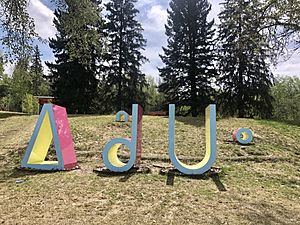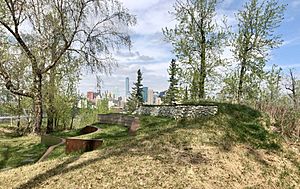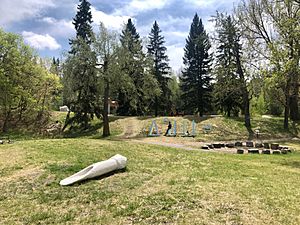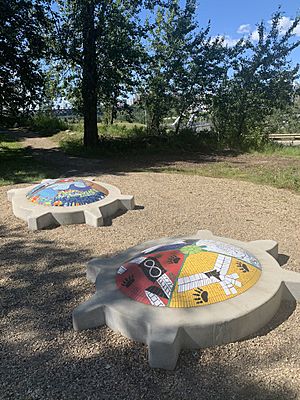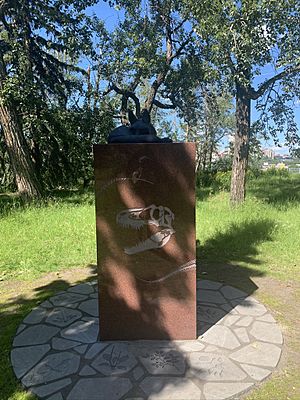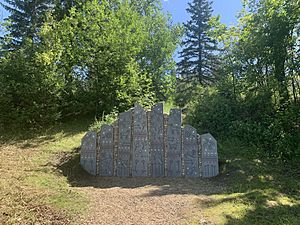Indigenous Art Park facts for kids
Quick facts for kids ᐄᓃᐤ (ÎNÎW) River Lot 11∞ |
|
|---|---|
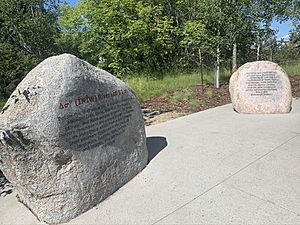
Entry rocks at Indigenous Art Park
|
|
| Location | 10380 Queen Elizabeth Park Road, Edmonton |
| Created | 2018 |
| Operated by | City of Edmonton and Edmonton Arts Council |
| Website | https://publicart.edmontonarts.ca/IAP/ |
Indigenous Art Park ᐄᓃᐤ (ÎNÎW) River Lot 11∞ (pronounced EE-nu River Lot 11) is a special public park in Edmonton, Alberta. It sits in the beautiful river valley. This park was built where the old Queen Elizabeth Pool used to be. In June 2019, a group called Americans for the Arts said it was one of the 50 best public art projects in the world! People started planning this park and choosing artworks by Indigenous artists in 2013. The park officially opened its doors in September 2018.
About the Park's Name and History
In the Cree language, ᐄᓃᐤ (ÎNÎW) means "I am of the Earth." This name is very important because the park is on the traditional lands of the Papaschase Cree people. Later, this area was known as River Lot 11. This was when a Métis landowner named Joseph McDonald lived there.
In 2013, the City of Edmonton and the Edmonton Arts Council started planning the art park. They held a workshop with local Indigenous communities and residents to get ideas. In December 2014, the City Council agreed to fund the park. They also created a special group to help with the project.
In August 2015, the Edmonton Arts Council asked Indigenous artists to share their ideas. A special art curator named Candice Hopkins helped 16 chosen artists. They visited the park site and learned from Indigenous communities and elders. This helped the artists understand the cultures, histories, and stories of the area. The artists then created designs for their art. Six of these designs were chosen in April 2016. Building the park started in 2017.
When the park opened in 2018 as ᐄᓃᐤ (ÎNÎW), it had six amazing artworks by Indigenous artists. It also had new walking trails, a covered seating area, and picnic tables.
Meet the Talented Artists
The art park's artworks were chosen by Candice Hopkins. She is from the Carcross/Tagish First Nation. Candice is a famous artist who has worked at big art places. These include the National Gallery of Canada and the Museum of Contemporary Native Art.
'ᐃᐢᑯᑌᐤ (iskotew)' by Amy Malbeuf
Amy Malbeuf is a Métis artist from Rich Lake, Alberta. She creates art that explores language, land, nature, and identity. Her artwork, ᐃᐢᑯᑌᐤ (iskotew), shows large sculptures of Cree letters. These letters spell the word "fire." Amy explains that the Cree word for woman, iskwew, comes from iskotew (fire). This shows how important Indigenous women are and how much they helped build this place.
The bright turquoise, pink, and yellow colors of the sculptures were inspired by beadwork. Amy saw a Métis fire bag with beadwork at the Royal Alberta Museum. She wanted to use colors that would stand out in the park. She also wanted them to show the lively spirit of Indigenous language and culture.
pehonan by Tiffany Shaw-Collinge
Tiffany Shaw-Collinge is a Métis artist and architect from Edmonton. Her artwork, pehonan, means "gathering or waiting place" in Cree. It is like an outdoor theater with different levels of seating. Tiffany designed each of the four levels to show a different time in history.
- The top level represents ancient times. Tiffany used quartzite stones from where her ancestors lived.
- The second level shows the time of fur trading in early Canada. The wood used looks like the log cabins Métis people built.
- The third level represents today's challenges to Indigenous culture. It uses weathered steel that will rust over time. This shows both the strength of Indigenous people and the harm caused by colonization. The steel also has a bead pattern from her grandmother's moccasins.
- The bottom level looks to the future. Tiffany used shiny mirrored steel. It reflects visitors and shows how Indigenous people use materials around them to create.
mikikwan by Duane Linklater
Duane Linklater is an Omaskêko Cree artist from Ontario. He creates sculptures, installations, and films. Duane's artwork, mikikwan, is a giant copy of a bone hide scraper. It sits on a hillside in the park. While researching at the Royal Alberta Museum, Duane saw thousands of objects. He chose a 9,000-year-old buffalo bone hide scraper found in southern Alberta.
Bone hide scrapers were important tools for making animal hides into clothing, drums, and rattles. Duane chose this tool to honor the work of Indigenous women. He also wanted to respect the buffalo's role in creating communities before they were hunted by settlers.
To make the artwork, Duane photographed the real tool. Then, a studio in Calgary made a concrete copy. The new artwork is much bigger than the original. Duane says that mikikwan is a monument to the hard work and design of Indigenous people. They still use this tool today.
mamohkamatowin (Helping Each Other) by Jerry Whitehead
Jerry Whitehead is a Cree artist from James Smith Cree Nation. He creates beadwork, murals, and paintings. Jerry's artwork features two large concrete turtles. They have colorful mosaics on their backs. These mosaics show ancient stories and represent the Cree creation story of Turtle Island.
The turtles are called "mother" and "baby." Each mosaic tells four stories. The mother turtle faces west. Its mosaic shows a sweat lodge, an eagle, the Northern Lights, teepees, dancers, a woodpecker (for the Papaschase people), a thunderbird, and a beaver.
For the baby turtle, Jerry worked with students and elders from amiskwaciy Academy in Edmonton. The baby turtle faces north. Its mosaic shows the Métis people, an eagle, a buffalo, and feathers. Jerry chose the name mamohkamatowin because "The whole project worked because people were helping each other continuously."
Reign by Mary Anne Barkhouse
Mary Anne Barkhouse is a jeweller and sculptor from Kwakiutl First Nation. Her art often uses animal images to talk about nature and Indigenous culture. Mary Anne's artwork has a 6-foot-tall polished red granite pillar. It has carvings of ancient animals like the Edmontosaurus and Albertosaurus. On top of the pillar is a bronze coyote, curled up but awake. At the bottom is a bronze jack rabbit, also lying down. These show a predator and prey pair.
At the base of the pillar, there is a mosaic of stones. These stones are carved with plants from the river valley. These plants include wild strawberry, blueberry, and kinnikinnick. The plants are included to show how they have always provided food and comfort in the area. Mary Anne said her art shows the balance in nature that has developed over time.
Preparing to Cross the Sacred River by Marianne Nicolson
Marianne Nicolson is an artist from the Dzawada’enuxw First Nation. She is skilled in painting, photography, sculpture, and traditional Kwakwaka’wakw carving. Her artwork's title points to the nearby North Saskatchewan River. The piece includes many references to the river's history. It shows its plants, animals, and how it has supported Indigenous peoples.
To create Preparing to Cross the Sacred River, Marianne used eight stone slabs of different heights. These slabs are connected with smooth river rocks. The stones are carved to look like petroglyphs (ancient rock carvings). But they have a modern style that looks like beadwork. Marianne talked to many elders for her research. They shared traditional stories that inspired the images on the stones. These images include geese, magpies, other animals, flowers, and arrows showing movement. The slabs also have carvings of a Métis cart and roses. Marianne explained that "preparing to cross the sacred river" means we need a new way of thinking about the land. This new way, based on Indigenous teachings, can help stop environmental damage.
Awards and Recognition
In June 2019, the Americans for the Arts' Public Art Network gave the park a special award. They called it one of the 50 best public art projects in the world. They said, "If public art shows where a community has been and where it's going, then ᐄᓃᐤ (ÎNÎW) River Lot 11∞ is a huge signpost on that journey."


